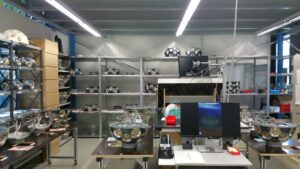Assembly room for optical modules, further designed, tested and constructed during the Preparatory phase. © KM3NeT Collaboration
In 2008, the Preparatory Phase for the KM3NeT infrastructure, funded by the European Seventh Framework Programme (EU FP7), started, in overlap with the KM3NeT Design Study, yet to be concluded. After KM3NeT was included in the ESFRI European Roadmap for Research Infrastructures, the new project represented the opportunity to provide the grounds to bring the telescope to its construction stage.
The primary objective of the KM3NeT Preparatory Phase was to pave the path to political and scientific convergence on the legal, governance, financial engineering and siting aspects of the infrastructure and to prepare rapid and efficient construction once approved.
As had become apparent during the KM3NeT Design Study, reconciliation of national and regional political and financial priorities with scientific and technological considerations became a major issue. The integration with regional and global marine and environmental systems (i.e. EMSO) as well as a convergence towards a pan European facility were also central to the project’s concerns.
In 2010, the KM3NeT consortium published three different options for the technology of the research infrastructure in the Technical Design Report. For two distinct technical designs, validation tests for several detector components were conducted. Due to delays in the in-situ validation program which required timely availability of deployment vessels and ROVs, the final Pre-Production Model of the major components were delivered in 2012-2014.
The KM3NeT Preparatory Phase was formally concluded in February 2012. The final choice for the technology was then formally agreed in a Memorandom of Understanding for implementation of the first phase of the KM3NeT neutrino telescope. The constitutional meeting of the KM3NeT Collaboration took place on 29 January 2013.
Once the Collaboration was established, the program of in-situ tests could be continued. In April 2013, a prototype of the multi-PMT optical module was connected to the network of the ANTARES telescope, where it was operated during a year. The result of the validation test was published in 2014. The in-situ validation of the Pre-Production Model for the detection unit started in May 2014. The unit was operated during more than a year. The result of the test was published in 2016.
The final design of the multi-PMT optical module and its production model was published in 2022.
In parallel with the development of the detection units, the electro-optical subsea networks between the units and the control stations on shore were implemented. The description of the optical layer of the network was published in 2023.



